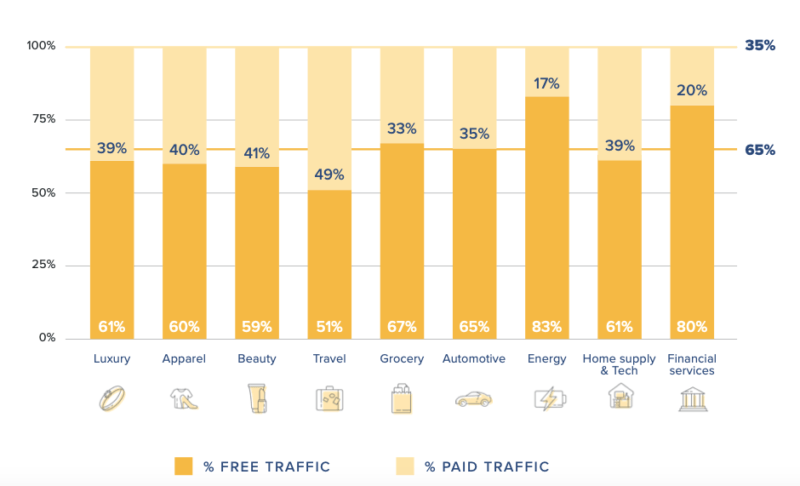A new benchmarking report (registration req’d) from Contentsquare contains a number of valuable metrics and datapoints, and one that is especially striking. On average, the report finds, 69% of all web content is not seen by consumers.
The report is based on an analysis of “12 months of Contentsquare data from 400 global websites in 9 different verticals.”
Organic/free sources drive majority of visits. Across the nine verticals studied, earned or “free” traffic represents 65% of all site visits. The report attributes this to “brand familiarity, repeat visits for regular purchases, and good brand awareness.” Financial services had the most organic or free traffic (80%), while travel saw the most paid visits (49%). Within travel there are probably some sites that see much more direct traffic, while others need to rely more heavily on ads.
For comparison, a 2019 study from BrightEdge found that 53% of site visits were driven by organic search. However, Contentsquare was looking at all sources of traffic, not simply search.
Earned/free traffic vs. paid traffic

Non-PC devices drive 60% of visits. The Contensquare report says, on average, 55% of site visits come from smartphones. When tablets are factored in, the total non-desktop traffic percentage is about 60%. This is consistent with earlier research from Hitwise (2016, 2019), suggesting that the desktop-mobile split has stabilized at roughly 60-40 overall.
Individual verticals, however, are more dynamic. And this is where it matters for marketers. The category with the highest percentage of mobile traffic according to Contensquare is luxury goods (67%), followed by apparel and beauty (66%). Financial services had the lowest percentage of mobile traffic (39%). There also doesn’t appear to be any direct relationship between product value (or consideration) and device used.
Percentage of traffic by device

Page load time 2.4 seconds. Contentsquare finds the [blended] average page-load time across industries in 2.39 seconds. The company reaffirms the conventional wisdom that slower loading sites see lower engagement or abandonment, especially on mobile. According to the report, there’s “a direct correlation between loading time and the number of pages viewed per session – 20% longer loading time means 20% fewer pages viewed.”
And most surprising perhaps, Contentsquare found that the majority of website content was “unseen.” Indeed, almost 70% of all content across categories was not viewed by potential customers. This was particularly acute in financial services, beauty, energy and automotive. And while there’s likely a more complex story here, the alarming implication is that a lot of the money spent content development is being wasted in many cases.
Percentage of content not seen by site visitors

Three visits before conversion. The study found “the average customer visits a website three times before making a purchase.” Strangely, financial services had the lowest pre-conversion visitation rate (2.39) while energy had the highest at 4.18, followed by luxury.
Number of visits before converting

Conversion percentages on mobile were uniformly lower than on the PC. This was especially true in the grocery vertical, where the gap between PC and mobile was most pronounced — although most grocery purchases convert offline. Conversion rates were closest in luxury goods, automotive and energy.
Contentsquare observed that seasonality and “peak shopping periods have a huge influence on conversion rate.” For example, during holiday shopping, the company said that “conversion rate increases by 27% compared with the rest of the year.”
Conversion rates by device

Why we care. Marketers spend tremendous amounts of money developing content for SEO and customer education. However, this report suggests some or a substantial portion of those budgets are wasted, if B2B and B2C customers aren’t seeing brands’ content, let alone engaging with it.

